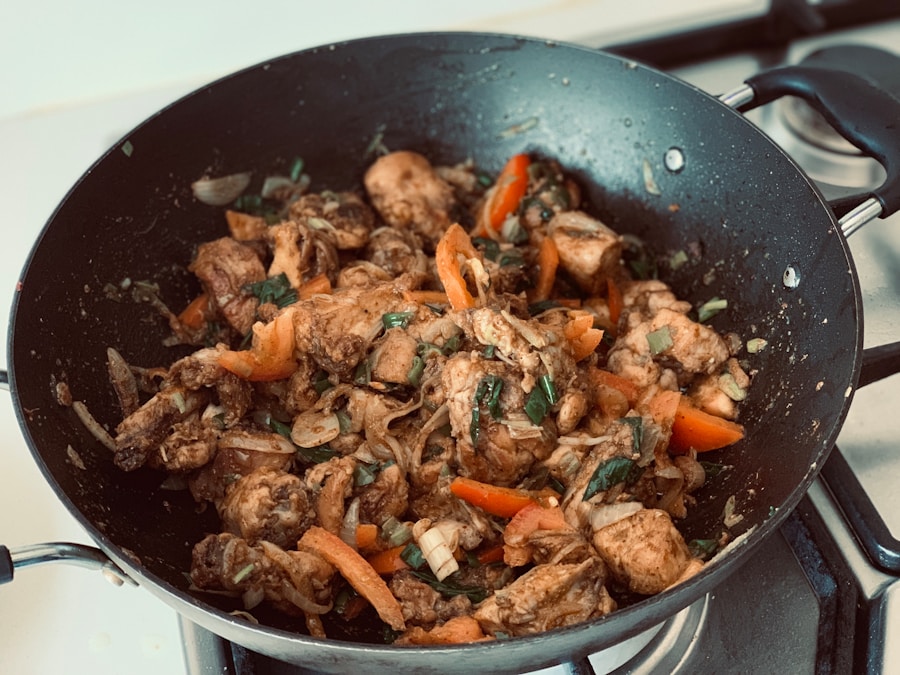The Ultimate Guide to Making Adobo: A Flavorful Filipino Dish
Description
Adobo, a dish that has become synonymous with Filipino cuisine, boasts a rich history that intertwines indigenous practices with colonial influences. The term “adobo” is derived from the Spanish word “adobar,” which means to marinate or season. This connection to Spanish colonization in the 16th century is significant, as it was during this period that the dish began to take shape in its current form.
However, the roots of adobo can be traced back even further to pre-colonial times when indigenous Filipinos utilized vinegar and salt to preserve meats. This method was not only practical for extending the shelf life of food in a tropical climate but also imparted a unique flavor profile that would later define the dish. The Spanish colonizers encountered this indigenous practice and adapted it, incorporating their own ingredients and techniques.
They introduced soy sauce, garlic, and bay leaves, which became staples in the adobo recipe. The melding of these culinary traditions resulted in a dish that reflects the diverse cultural influences present in the Philippines. Over time, adobo evolved into various regional interpretations, each showcasing local ingredients and cooking methods.
This adaptability has allowed adobo to remain a beloved staple in Filipino households, symbolizing both comfort and cultural identity.
Key Takeaways
- Adobo originated in the Philippines during the Spanish colonial period and has evolved into a beloved national dish with various regional and personal variations.
- Essential ingredients for making adobo include meat (chicken, pork, or beef), vinegar, soy sauce, garlic, bay leaves, and black peppercorns.
- Different variations of adobo include regional twists such as adding coconut milk or using different types of vinegar, as well as personal preferences for spiciness and sweetness.
- A step-by-step guide to making adobo includes marinating the meat, searing it in a hot pan, simmering it in the marinade, and adjusting the seasoning to taste.
- Pairing adobo with sides and beverages can create a well-rounded meal, with popular choices including steamed rice, pickled vegetables, and a cold beverage like iced tea or beer.
- Storing and reheating adobo can be done by transferring it to an airtight container and refrigerating it for up to 3 days, then reheating it in a pan or microwave until heated through.
Essential Ingredients for Making Adobo
At its core, adobo is characterized by a few essential ingredients that contribute to its distinctive flavor. The primary components include meat—commonly chicken or pork—vinegar, soy sauce, garlic, bay leaves, and black peppercorns. The choice of meat can vary based on personal preference or regional availability; some variations even incorporate seafood or vegetables.
The use of vinegar is crucial, as it not only acts as a preservative but also provides the tangy flavor that is a hallmark of adobo. Different types of vinegar can be used, such as cane vinegar or coconut vinegar, each imparting its unique taste to the dish. Soy sauce complements the vinegar by adding depth and umami, creating a balanced flavor profile.
Garlic is often used liberally in adobo recipes, contributing aromatic qualities that enhance the overall experience. Bay leaves are typically added during the cooking process to infuse the dish with a subtle herbal note. Black peppercorns provide a gentle heat that rounds out the flavors.
While these ingredients form the foundation of traditional adobo, many cooks also experiment with additional elements such as onions, chili peppers, or even coconut milk to create their own signature versions.
Different Variations of Adobo: Regional and Personal Twists

The beauty of adobo lies in its versatility, allowing for countless variations that reflect regional preferences and personal tastes. In the Philippines, different provinces have developed their own unique takes on this classic dish. For instance, in the Ilocos region, adobo is often made with a more pronounced vinegar flavor and may include additional spices like ginger or even sugar to balance the acidity.
This version is known as “Ilocos adobo” and is typically prepared with pork or chicken. In contrast, the Visayas region showcases “adobong puti,” which translates to “white adobo.” This variation omits soy sauce entirely, relying solely on vinegar for flavoring. The result is a lighter-colored dish that emphasizes the tanginess of the vinegar and often includes coconut milk for added richness.
Beyond regional differences, personal twists on adobo are common among families and home cooks. Some may choose to add hard-boiled eggs or potatoes for heartiness, while others might experiment with different types of meat or even tofu for a vegetarian option.
The adaptability of adobo allows it to evolve continuously, making it a canvas for culinary creativity while still honoring its traditional roots.
Step-by-Step Guide to Making Adobo: Cooking Techniques and Tips
| Adobo Ingredient | Quantity |
|---|---|
| Chicken or Pork | 1 kg |
| Soy Sauce | 1/2 cup |
| Vinegar | 1/2 cup |
| Garlic | 5 cloves, minced |
| Bay Leaves | 3 pieces |
| Peppercorns | 1 teaspoon |
| Water | 1 cup |
Creating a delicious adobo at home involves several key steps that ensure the flavors meld beautifully. To begin, select your choice of meat—chicken thighs or pork belly are popular options due to their tenderness and ability to absorb flavors well. Start by marinating the meat in a mixture of vinegar, soy sauce, minced garlic, bay leaves, and black peppercorns for at least 30 minutes; this step is crucial for infusing flavor into the meat.
Once marinated, heat a pot over medium heat and add a small amount of oil. Sear the meat until it develops a golden-brown crust on all sides; this step enhances the overall flavor through caramelization. After browning the meat, pour in the marinade along with enough water to cover the meat partially.
Bring the mixture to a boil before reducing the heat to low and allowing it to simmer gently. This slow cooking process allows the meat to become tender while absorbing the rich flavors of the marinade. As the adobo simmers, it’s essential to taste and adjust seasoning as needed.
Some cooks prefer their adobo to be more tangy and may add extra vinegar, while others might lean towards a sweeter profile by incorporating sugar or even pineapple juice. The cooking time can vary depending on the type of meat used; chicken typically takes about 30-40 minutes, while pork may require up to an hour for optimal tenderness. Once cooked, let the adobo rest for a few minutes before serving; this allows the flavors to settle and intensify.
Pairing Adobo with Sides and Beverages: Creating a Well-Rounded Meal
Adobo is often enjoyed as part of a larger meal, and selecting complementary sides can elevate the dining experience significantly. A classic pairing is steamed white rice, which serves as a neutral base that absorbs the flavorful sauce of the adobo. The simplicity of rice allows the bold flavors of the dish to shine through without overwhelming the palate.
For those seeking additional texture and flavor, fried rice or garlic rice can also be delightful alternatives. Vegetable sides are another excellent way to round out an adobo meal. Dishes such as sautéed greens—like bok choy or spinach—provide a fresh contrast to the richness of adobo.
Additionally, pickled vegetables or achara (pickled green papaya) can introduce acidity and crunch that balance out the savory elements of the dish. These sides not only enhance the meal but also contribute nutritional variety. When it comes to beverages, pairing adobo with drinks that complement its robust flavors can enhance the overall dining experience.
Traditional options include cold beverages like iced tea or lemonade, which offer refreshing contrasts to the savory notes of adobo. For those who prefer alcoholic beverages, light beers or Filipino cocktails such as lambanog (a coconut spirit) can provide an interesting pairing that highlights local flavors.
Storing and Reheating Adobo: Tips for Enjoying Leftovers

One of the advantages of adobo is its ability to taste even better after being stored and reheated.
To store adobo properly, allow it to cool completely before transferring it to an airtight container.
It can be kept in the refrigerator for up to three days or frozen for longer storage—up to three months without significant loss of quality. When reheating adobo, there are several methods to consider depending on personal preference and available time. For those who prefer stovetop reheating, simply place the adobo in a saucepan over low heat and stir occasionally until warmed through.
Adding a splash of water or additional vinegar can help maintain moisture during reheating. Alternatively, using a microwave is convenient for quick meals; just ensure that you cover the dish to prevent splattering while heating. Regardless of how you choose to reheat your adobo, it’s essential to taste it again before serving.
You may find that it needs a touch more seasoning or acidity after being stored. Some people enjoy adding fresh herbs or additional garlic just before serving to refresh its flavor profile. With these tips in mind, enjoying leftover adobo can be just as satisfying as savoring it fresh from the pot.
FAQs
What is Adobo?
Adobo is a popular Filipino dish that involves marinating meat, seafood, or vegetables in a mixture of vinegar, soy sauce, garlic, and other seasonings, then simmering it until tender.
What are the main ingredients in Adobo?
The main ingredients in Adobo typically include vinegar, soy sauce, garlic, bay leaves, and black peppercorns. The dish can be made with various proteins such as chicken, pork, beef, or seafood.
How is Adobo cooked?
To cook Adobo, the meat or other main ingredient is marinated in the vinegar and soy sauce mixture, then simmered in the same marinade until tender. It is often served with rice.
Is Adobo spicy?
Adobo can be made spicy by adding chili peppers or hot sauce to the marinade, but it is not traditionally a spicy dish. The level of spiciness can be adjusted to suit individual preferences.
What is the origin of Adobo?
Adobo is a traditional Filipino dish that has its roots in Spanish cuisine. The cooking method of marinating and stewing meat in vinegar and spices was introduced by the Spanish during their colonization of the Philippines.





